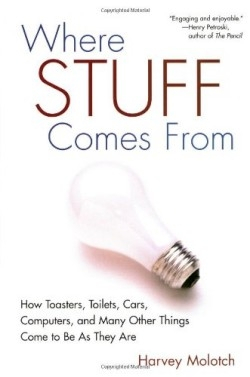Where Stuff Comes From
How Toasters Toilets Cars Computers and Many Other Things Come to Be As They Are
Computer keyboards could be different, as could the conventional Western toilet. The author wants to know how and why these objects and others came to be the way they are. For Molotch, holder of a joint appointment as professor of Metropolitan Studies and Sociology at New York University and Professor of Sociology at the University of California, Santa Barbara, every object has a story. Computer keyboards evolved from the typewriter. Toilets might slant backward to accommodate squatting, but that would offend Western sensibilities.
While every object has its own narrative, nothing stands alone; each item is just one interdependent fragment within the larger whole. In Molotch’s objective analysis, everything must somehow “lash up.” A toaster presupposes a countertop, a nearby electric outlet, some sliced bread, and a jar of jam.
Molotch’s purpose is not to be judgmental, but just to show how and why certain products take hold. Accordingly, he eschews product evaluation and avoids condemnation of popular choice, though a caustic opinion or two might have enlivened the narrative’s occasional dry spot. Happenstance plays a big part in the way things are. When a new glue at 3M failed to stick, the Post-it was created; but luck is never totally dumb. The Post-it might never have caught on if 3M hadn’t already had in place a system for production and distribution. Pre-existing infrastructure also plays a role. To demonstrate this, Molotch draws a direct line from the width of Roman chariots to the size of the space shuttle’s rocket boosters. The boosters travel by train; the distance between 19th-century carriage wheels determined the width of the standard railroad track; and the first carriage wheels were constructed to roll in ancient Roman road ruts.
Some of the stuff now seems to be destroying the earth, so the challenge is to find a new way of doing things. Molotch cautions that because every object has a Gestalt, this will not be easy. The private car, for example, is lashed up with roads, parking lots, the aesthetics of movement, and a teenager’s rite of passage.
Early in the book, Molotch makes the tantalizing suggestion that he will conclude with a discussion of how things might have turned out differently; he generally fails to deliver on this promise, a minor disappointment in an otherwise comprehensive, accessible analysis.
Reviewed by
Rob Mitchell
Disclosure: This article is not an endorsement, but a review. The publisher of this book provided free copies of the book to have their book reviewed by a professional reviewer. No fee was paid by the publisher for this review. Foreword Reviews only recommends books that we love. Foreword Magazine, Inc. is disclosing this in accordance with the Federal Trade Commission’s 16 CFR, Part 255.

